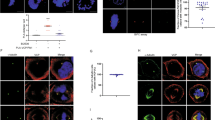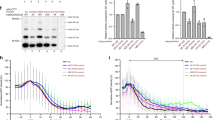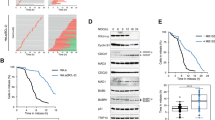Abstract
Protein phosphatase 2A (PP2A) in complex with B55 regulatory subunits reverses cyclin-dependent kinase 1 (Cdk1) phosphorylations at mitotic exit1,2,3,4,5. Interestingly, threonine and serine residues phosphorylated by Cdk1 display distinct phosphorylation dynamics, but the biological significance remains unexplored. Here we demonstrate that the phosphothreonine preference of PP2A–B55 provides an essential regulatory element of mitotic exit. To allow rapid activation of the anaphase-promoting complex/cyclosome (APC/C) co-activator Cdc20, inhibitory phosphorylation sites are conserved as threonines while serine substitutions delay dephosphorylation and Cdc20 activation. Conversely, to ensure timely activation of the interphase APC/C co-activator Cdh1, inhibitory phosphorylation sites are conserved as serines, and threonine substitutions result in premature Cdh1 activation. Furthermore, rapid translocation of the chromosomal passenger complex to the central spindle is prevented by mutation of a single phosphorylated threonine to serine in inner centromere protein (INCENP), leading to failure of cytokinesis. Altogether, the findings of our work reveal that the inherent residue preference of a protein phosphatase can provide temporal regulation in biological processes.
This is a preview of subscription content, access via your institution
Access options
Access Nature and 54 other Nature Portfolio journals
Get Nature+, our best-value online-access subscription
$29.99 / 30 days
cancel any time
Subscribe to this journal
Receive 12 print issues and online access
$209.00 per year
only $17.42 per issue
Buy this article
- Purchase on Springer Link
- Instant access to full article PDF
Prices may be subject to local taxes which are calculated during checkout





Similar content being viewed by others
References
Schmitz, M. H. A. et al. Live-cell imaging RNAi screen identifies PP2A–B55α and importin-β1 as key mitotic exit regulators in human cells. Nat. Cell Biol. 12, 886–893 (2010).
Mochida, S., Ikeo, S., Gannon, J. & Hunt, T. Regulated activity of PP2A–B55 δ is crucial for controlling entry into and exit from mitosis in Xenopus egg extracts. EMBO J. 28, 2777–2785 (2009).
Manchado, E. et al. Targeting mitotic exit leads to tumor regression in vivo: modulation by Cdk1, Mastl, and the PP2A/B55α,δ phosphatase. Cancer Cell 18, 641–654 (2010).
Agostinis, P., Derua, R., Sarno, S., Goris, J. & Merlevede, W. Specificity of the polycation-stimulated (type-2A) and ATP, Mg-dependent (type-1) protein phosphatases toward substrates phosphorylated by P34cdc2 kinase. Eur. J. Biochem. 205, 241–248 (1992).
Mayer-Jaekel, R. E. et al. The 55 kd regulatory subunit of Drosophila protein phosphatase 2A is required for anaphase. Cell 72, 621–633 (1993).
Suzuki, K. et al. Identification of non-Ser/Thr-Pro consensus motifs for Cdk1 and their roles in mitotic regulation of C2H2 zinc finger proteins and Ect2. Sci. Rep. 5, 7929 (2015).
Chen, C. et al. Identification of a major determinant for serine-threonine kinase phosphoacceptor specificity. Mol. Cell 53, 140–147 (2014).
Pinna, L. A., Donella, A., Clari, G. & Moret, V. Preferential dephosphorylation of protein bound phosphorylthreonine and phosphorylserine residues by cytosol and mitochondrial “casein phosphatases”. Biochem. Biophys. Res. Commun. 70, 1308–1315 (1976).
Deana, A. D., Marchiori, F., Meggio, F. & Pinna, L. A. Dephosphorylation of synthetic phosphopeptides by protein phosphatase-T, a phosphothreonyl protein phosphatase. J. Biol. Chem. 257, 8565–8568 (1982).
Deana, A. D. & Pinna, L. A. Identification of pseudo ‘phosphothreonyl-specific’ protein phosphatase T with a fraction of polycation-stimulated protein phosphatase 2A. Biochim. Biophys. Acta 968, 179–185 (1988).
Cundell, M. J. et al. A PP2A-B55 recognition signal controls substrate dephosphorylation kinetics during mitotic exit. J. Cell Biol. 214, 539–554 (2016).
McCloy, R. A. et al. Global phosphoproteomic mapping of early mitotic exit in human cells identifies novel substrate dephosphorylation motifs. Mol. Cell Proteomics 14, 2194–2212 (2015).
Malik, R. et al. Quantitative analysis of the human spindle phosphoproteome at distinct mitotic stages. J. Proteome Res. 8, 4553–4563 (2009).
Godfrey, M. et al. PP2A(Cdc55) phosphatase imposes ordered cell-cycle phosphorylation by opposing threonine phosphorylation. Mol. Cell 65, 393–402 (2017).
Pines, J. Cubism and the cell cycle: the many faces of the APC/C. Nat. Rev. Mol. Cell Biol. 12, 427–438 (2011).
Labit, H. et al. Dephosphorylation of Cdc20 is required for its C-box-dependent activation of the APC/C. EMBO J. 31, 3351–3362 (2012).
Yudkovsky, Y., Shteinberg, M., Listovsky, T., Brandeis, M. & Hershko, A. Phosphorylation of Cdc20/fizzy negatively regulates the mammalian cyclosome/APC in the mitotic checkpoint. Biochem. Biophys. Res. Commun. 271, 299–304 (2000).
Strickfaden, S. C. et al. A mechanism for cell-cycle regulation of MAP kinase signaling in a yeast differentiation pathway. Cell 128, 519–531 (2007).
Zhang, S. et al. Molecular mechanism of APC/C activation by mitotic phosphorylation. Nature 533, 260–264 (2016).
Fujimitsu, K., Grimaldi, M. & Yamano, H. Cyclin-dependent kinase 1-dependent activation of APC/C ubiquitin ligase. Science 352, 1121–1124 (2016).
Qiao, R. et al. Mechanism of APC/CCDC20 activation by mitotic phosphorylation. Proc. Natl Acad. Sci. USA 113, 2570–2578 (2016).
Hein, J. B. & Nilsson, J. Interphase APC/C-Cdc20 inhibition by cyclin A2–Cdk2 ensures efficient mitotic entry. Nat. Commun. 7, 10975 (2016).
Gharbi-Ayachi, A. et al. The substrate of Greatwall kinase, Arpp19, controls mitosis by inhibiting protein phosphatase 2A. Science 330, 1673–1677 (2010).
Mochida, S., Maslen, S. L., Skehel, M. & Hunt, T. Greatwall phosphorylates an inhibitor of protein phosphatase 2A that is essential for mitosis. Science 330, 1670–1673 (2010).
Floyd, S., Pines, J. & Lindon, C. APC/C Cdh1 targets aurora kinase to control reorganization of the mitotic spindle at anaphase. Curr. Biol. 18, 1649–1658 (2008).
Chang, L., Zhang, Z., Yang, J., McLaughlin, S. H. & Barford, D. Atomic structure of the APC/C and its mechanism of protein ubiquitination. Nature 522, 450–454 (2015).
Kramer, E. R., Scheuringer, N., Podtelejnikov, A. V., Mann, M. & Peters, J. M. Mitotic regulation of the APC activator proteins CDC20 and CDH1. Mol. Biol. Cell 11, 1555–1569 (2000).
Zeng, X. et al. Pharmacologic inhibition of the anaphase-promoting complex induces a spindle checkpoint-dependent mitotic arrest in the absence of spindle damage. Cancer Cell 18, 382–395 (2010).
van der Horst, A. & Lens, S. M. A. Cell division: control of the chromosomal passenger complex in time and space. Chromosoma 123, 25–42 (2014).
Hümmer, S. & Mayer, T. U. Cdk1 negatively regulates midzone localization of the mitotic kinesin Mklp2 and the chromosomal passenger complex. Curr. Biol. 19, 607–612 (2009).
Goto, H. et al. Complex formation of Plk1 and INCENP required for metaphase–anaphase transition. Nat. Cell Biol. 8, 180–187 (2006).
Hertz, E. P. T. et al. A conserved motif provides binding specificity to the PP2A–B56 phosphatase. Mol. Cell 63, 686–695 (2016).
Bremmer, S. C. et al. Cdc14 phosphatases preferentially dephosphorylate a subset of cyclin-dependent kinase (Cdk) sites containing phosphoserine. J. Biol. Chem. 287, 1662–1669 (2012).
Kemp, B. E. Relative alkali stability of some peptide o-phosphoserine and o-phosphothreonine esters. FEBS Lett. 110, 308–312 (1980).
Donella Deana, A., Krinks, M. H., Ruzzene, M., Klee, C. & Pinna, L. A. Dephosphorylation of phosphopeptides by calcineurin (protein phosphatase 2B). Eur. J. Biochem. 219, 109–117 (1994).
Hein, J. B. & Nilsson, J. Stable MCC binding to the APC/C is required for a functional spindle assembly checkpoint. EMBO Rep. 15, 264–272 (2014).
Cundell, M. J. et al. The BEG (PP2A–B55/ENSA/Greatwall) pathway ensures cytokinesis follows chromosome separation. Mol. Cell 52, 393–405 (2013).
Sedgwick, G. G. et al. Mechanisms controlling the temporal degradation of Nek2A and Kif18A by the APC/C–Cdc20 complex. EMBO J. 32, 303–314 (2013).
Acknowledgements
We thank T. Mayer and A. Heim (Universitat Konstanz, Germany), J. Pines (ICR, United Kingdom), D. Hermida Aponte and C. Lukas (Novo Nordisk Foundation Center for Protein Research, Denmark) for reagents and discussion, and the CPR protein production facility and, in particular, G. Cazzamali, M. Williamson, A. L. L. Vala and H. Koc in the eukaryotic and prokaryotic expression teams for purifying Cdc20 proteins. The Novo Nordisk Foundation Center for Protein Research, University of Copenhagen, is supported financially by the Novo Nordisk Foundation (grant agreement NNF14CC0001). In addition, this work was supported by grants from the Danish Cancer Society (R72-A4351-13-S2 and R124-A7827-15-S2), a grant from the Danish Council for Independent Research (DFF-4183-00388) and a grant from the Novo Nordisk Foundation (NNF16OC0022394) to J.N.
Author information
Authors and Affiliations
Contributions
All authors contributed to project planning and data analysis of their respective experiments and J.N. coordinated the work. J.B.H. performed all analysis of Cdc20 and Cdh1, except in vitro APC/C ubiquitylation assays performed by D.H.G. E.P.T.H. performed Michaelis–Menten kinetics analysis of PP2A–B55 and all in vitro kinase and phosphatase assays and phosphorylation of Arpp19. T.K. performed in vivo analysis of INCENP. J.B.H. and D.H.G. performed analysis of phosphoantibodies. All authors contributed to the writing of the paper.
Corresponding author
Ethics declarations
Competing interests
The authors declare no competing financial interests.
Integrated supplementary information
Supplementary Figure 1
(A) Michaelis-Menten kinetic parameters of purified PP2A-B55α holoenzyme were determined against 16-mer phospho-peptides originating from Cdh1 144-158 (pS151: WDVSPYSL(pS)PVSNKSQ; pT151 WDVSPYSL(pT)PVSNKSQ) using malachite green phosphatase assay. Mean and standard deviation shown in plot (n = 3 independent experiments). (B) Endogenous Cdc20 was depleted by RNAi in HeLa cells using the outlined protocol and complemented with the indicated YFP tagged forms of Cdc20 and mitotic duration was determined using live cell microscopy (n values are shown in the graph and represent single cells analyzed per condition, Median and interquartile range indicated by red lines from 2 independent experiments). Representative still images are shown below. Scale bar; 10 μm. (C) Mitotic APC/C devoid of Cdc20 was incubated with the indicated purified Strep tagged Cdc20 proteins. After washing the amount of Cdc20 remaining/bound was determined by western blot.
Supplementary Figure 2
(A) Conservation of APC1 residues in different species. (B) Purified GST or indicated GST-Arpp19 proteins were phosphorylated with purified MASTL in the presence of [γ-32P] labeled ATP and reactions separated by SDS-PAGE and analyzed by autoradiography. GST-Arpp19 proteins phosphorylated with MASTL using ATPγS was incubated with a mitotic extract from HeLa cells expressing myc-tagged PP2AC. Next, the GST-tagged proteins were purified and analyzed for bound PP2A-C. The experiment was performed once. (C) B55 isoforms were depleted as indicated and Cdc20 immunopurified following release from a nocodazole block at the indicated times. The level of Cdc20 T70 phosphorylation and total Cdc20 purified was determined (data represent 1 out 3 experiments with similar results). Quantification of Cdc20 T70 phosphorylation for the specific experiment is shown below. (D) Analysis of the experiments in Fig. 2a measuring the time from nuclear envelope breakdown (NEBD) to metaphase and the time from metaphase to anaphase. The timing of mitotic events was determined from the DIC images and only cells allowing clear determination of metaphase were analyzed. (n = 30 cells analyzed per condition from 3 independent experiments, median with interquartile range indicated by red lines). (E) Analysis of the localization of YFP tagged Cdc20 wt and Cdc20 3SP from cells progressing through an unperturbed mitosis. Representative images from a cell in prometaphase and metaphase are shown. More than 20 cells were analyzed. Scale bars; 10 μm.
Supplementary Figure 3
(A) Calibration of Cdc20 T70 phospho-specific antibody. GST-Cdc20 47–78 wt was phosphorylated in vitro with cdk1-cyclinB using [γ-32P] labeled ATP. The sample was blotted on PVDF and the Cdc20 T70 signal determined by quantitative western blot and then analyzed by autoradiography. Cdc20 T70p antibody signal was normalized to [32P] signal and the value obtained from the Cdc20 3S was multiplied by the Cdc20 wt to determine how well the T70p antibody recognizes the S70p epitope. The obtained value was used to calculate to what extent Cdc20 3SP was phosphorylated in cell extracts. Values are quantified signal intensities. The experiment was performed once. (B) The APC/C was purified from nocodazole arrested cells using a monoclonal APC4 antibody and then control treated or treated with lambda phosphatase as indicated. Different amounts of purified APC/C was analyzed by western-blot and probed with the indicated antibodies. Data show 1 out of 2 independent experiments with similar results. (C) As in B with cells depleted of either APC1 or APC3 using specific RNAi oligoes. Note that depletion of APC1 destabilizes the APC/C. Data show 1 out of 2 independent experiments with similar results. (D) HeLa cells synchronized using a double thymidine arrest and release protocol were released from the final thymidine block (t = 0) and the APC/C purified at the indicated times. The samples were analyzed by western-blot with the indicated antibodies. The level of APC1 S355p intensity was normalized to APC4 intensity on the diagram to the right. Data show 1 out of 2 independent experiments with similar results. (E) HeLa cells were transfected with YFP-Cdh1 wt or mutants thereof and then YFP-Cdh1 proteins were isolated from mitotic cells using a YFP affinity resin. YFP-Cdh1 wt sample was treated with lambda phosphatase as indicated and then different amounts of purified YFP-Cdh1 proteins were analyzed by western-blot using the indicated antibodies. The quantification is shown for 8 ul sample as this allows for more accurate quantification. Data show 1 out of 2 independent experiments with similar results.
Supplementary Figure 4
(A) Hela cells stably expressing YFP tagged Cdh1 were synchronized by double thymidine treatment, depleted of Cdc20 and mitotic duration was determined using live cell microsopy (n values are shown in the graph and represent single cells analyzed per condition from 3 independent experiments, Median and interquartile range indicated by red lines, Mann–Whitney Test P < 0.0001). (B) As in A but in the presence of 30 ng ml−1 nocodazole (n values are shown in the graph and represent single cells analyzed per condition from 3 independent experiments, Median and interquartile range indicated by red lines, Mann–Whitney Test (two-tailed) P < 0.0001). Scale bar, 10 μm.
Supplementary information
Supplementary Information
Supplementary Information (PDF 50480 kb)
Supplementary Table 1
Supplementary Information (XLSX 41 kb)
Supplementary Table 2
Supplementary Information (XLSX 49 kb)
Rights and permissions
About this article
Cite this article
Hein, J., Hertz, E., Garvanska, D. et al. Distinct kinetics of serine and threonine dephosphorylation are essential for mitosis. Nat Cell Biol 19, 1433–1440 (2017). https://doi.org/10.1038/ncb3634
Received:
Accepted:
Published:
Issue Date:
DOI: https://doi.org/10.1038/ncb3634
This article is cited by
-
Alternative CDC20 translational isoforms tune mitotic arrest duration
Nature (2023)
-
PP2A-B55: substrates and regulators in the control of cellular functions
Oncogene (2022)
-
Human SLFN5 and its Xenopus Laevis ortholog regulate entry into mitosis and oocyte meiotic resumption
Cell Death Discovery (2022)
-
The study of the determinants controlling Arpp19 phosphatase-inhibitory activity reveals an Arpp19/PP2A-B55 feedback loop
Nature Communications (2021)
-
Wip1 controls the translocation of the chromosomal passenger complex to the central spindle for faithful mitotic exit
Cellular and Molecular Life Sciences (2021)



